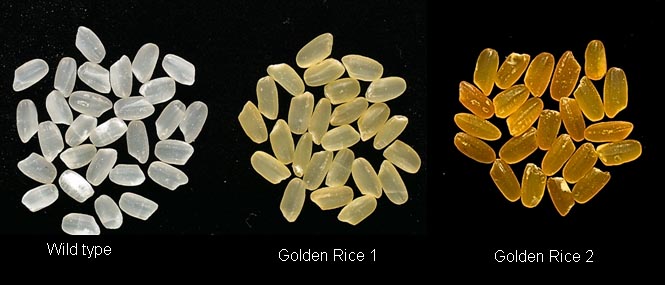From prototype to product
The most widespread micronutrient deficiencies in humans are due to the lack of iron, zinc, and vitamin A. They are also the cause of major morbidity and mortality. Vitamin A deficiency is prevalent in rice-based societies, especially among the poor who cannot afford a balanced diet. This becomes more acute in remote rural areas, where subsistence farmers grow their own rice and little else, mainly because their small fields must provide sustenance for whole families the year over. This combination leads to rice being the main and often sole crop in many Asian countries, the same way as it may lead to other starchy, storable crops in other parts of the world. Rice provides the necessary calories to cover the daily energy needs. It is also an essential part of ancient cultures, as it is well adapted to local climatic and soil conditions, and it is easily prepared in many ways.
Sadly, while rice grains contain other important nutrients, they do not contain provitamin A, not even in the unpolished grains. Hence, dependence on rice as the predominant food source unavoidably leads to vitamin A deficiency, most severely affecting children and pregnant women.

A major goal of the Golden Rice Project is to supply consumers in rice-based societies with the recommended daily intake of vitamin A. The tools necessary to achieve this goal are available since the development of an advanced version of Golden Rice known as GR2. The picture above shows the pleasant orange, translucent colour of GR2, which stems from an increased accumulation of β-carotene in the grain as compared to the earlier GR1 version.
Golden Rice, which is the result of targeted genetic engineering, offers a partial solution to a global problem. The approach consists of introducing the necessary enzymes to enable the rice grains to process precursor molecules present in the grain and thus activate the biochemical pathway to β-carotene production. This pathway is active in rice leaves but is turned off in the grain during development. Thus, no new substance is being produced. The modification only consists in producing β-carotene in a tissue where the plant normally doesn't produce it, i.e. in the grain. The reason why the plant turns off this pathway is because the plant doesn't need it there; pigments like β-carotene are usually needed only in photosynthetic tissues.
β-Carotene accumulation in carrots is the result of a mutation selected by a breeder and not the natural state of carrots, which are either white or dark purple. In the quest for more nutritious or higher yielding crops, farmers and breeders over the last ten-thousand years or so have selected characteristics that are not always of benefit to the plant but to humans, exactly as we're doing now with Golden Rice.
Our goal is to complement ongoing health programs by increasing the coverage of vitamin supply, especially in remote rural areas. Our hopes are rooted in the fact that biofortified seed represent a sustainable approach to enriching diets with the needed micronutrients. Once farmers start growing Golden Rice, funds used to run some supplementation programs —costing millions of dollars every year and distirbuted in the form of pills and capsules— could be freed and redirected to other much needed programs. Experience has demonstrated that rice will remain a major caloric intake source for billions of people, because it is easy to grow, well adapted for long term storage, and cheap to obtain. Good β-carotene sources are not grown everywhere where vitamin deficiency is a problem. Moreover, we now know that bioavailability of β-carotene from vegetables is lower than previously thought, and thus the required increase in daily vegetable intake would be economically unattainable for many poor people.
